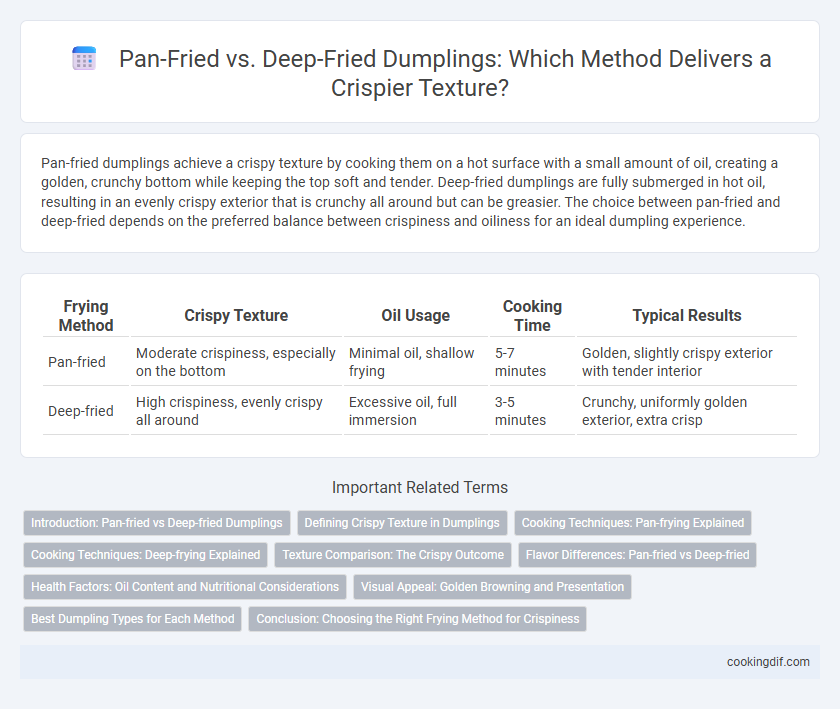Pan-fried dumplings achieve a crispy texture by cooking them on a hot surface with a small amount of oil, creating a golden, crunchy bottom while keeping the top soft and tender. Deep-fried dumplings are fully submerged in hot oil, resulting in an evenly crispy exterior that is crunchy all around but can be greasier. The choice between pan-fried and deep-fried depends on the preferred balance between crispiness and oiliness for an ideal dumpling experience.
Table of Comparison
| Frying Method | Crispy Texture | Oil Usage | Cooking Time | Typical Results |
|---|---|---|---|---|
| Pan-fried | Moderate crispiness, especially on the bottom | Minimal oil, shallow frying | 5-7 minutes | Golden, slightly crispy exterior with tender interior |
| Deep-fried | High crispiness, evenly crispy all around | Excessive oil, full immersion | 3-5 minutes | Crunchy, uniformly golden exterior, extra crisp |
Introduction: Pan-fried vs Deep-fried Dumplings
Pan-fried dumplings achieve a crispy texture with a golden, slightly chewy bottom while maintaining a tender, steamed top, offering a balanced contrast in every bite. Deep-fried dumplings, by contrast, deliver an all-around crunchy exterior due to complete immersion in hot oil, resulting in a crispier and richer flavor profile. Choosing between pan-frying and deep-frying depends on preferred texture intensity and cooking method, with pan-frying favored for subtle crispiness and deep-frying for maximum crunch.
Defining Crispy Texture in Dumplings
Crispy texture in dumplings is defined by a golden-brown, crunchy exterior that contrasts with a tender, juicy filling, achieved through specific cooking techniques. Pan-fried dumplings develop a thin, crisp bottom due to direct contact with a hot, oiled skillet, while deep-fried dumplings attain an even, all-around crunch from immersion in hot oil. The choice between pan-frying and deep-frying affects moisture retention, oil absorption, and the overall balance of crispiness and flavor in the dumpling's texture.
Cooking Techniques: Pan-frying Explained
Pan-frying dumplings involves cooking them in a small amount of oil over medium heat, allowing the bottom to develop a golden, crispy crust while the top remains tender and steamed. This technique uses a combination of frying and steaming by adding water and covering the pan, ensuring the dumplings are cooked through without excessive oil absorption. Pan-frying provides a balanced texture with a crunchy exterior and juicy interior compared to the uniformly crispy but greasier deep-fried dumplings.
Cooking Techniques: Deep-frying Explained
Deep-frying dumplings involves submerging them fully in hot oil at temperatures between 350degF and 375degF, creating a uniformly crispy exterior by rapidly cooking the wrapper and sealing in moisture. This technique produces a golden-brown crust that contrasts with a juicy, tender filling, making it ideal for achieving maximum crunchiness. Pan-frying typically uses less oil and results in a partially crispy texture mainly on one side, whereas deep-frying ensures an all-around crisp surface.
Texture Comparison: The Crispy Outcome
Pan-fried dumplings achieve a crispy texture on the bottom while maintaining a tender, steamed top, creating a balanced contrast between crunch and softness. Deep-fried dumplings deliver an even, golden crispness across the entire surface, resulting in a uniformly crunchy bite. The choice between pan-fried and deep-fried methods depends on the desired texture intensity and overall mouthfeel.
Flavor Differences: Pan-fried vs Deep-fried
Pan-fried dumplings offer a balanced crispy texture with a golden-brown crust while retaining a tender, juicy interior, enhancing the savory flavor of the filling. Deep-fried dumplings deliver an intensely crunchy and oily exterior, which intensifies the richness but can mask subtle flavor notes in the filling. Choosing between pan-fried and deep-fried methods depends on whether the preference is for a harmonious, crispy bite or a bold, indulgently textured dumpling experience.
Health Factors: Oil Content and Nutritional Considerations
Pan-fried dumplings contain less oil compared to deep-fried ones, resulting in lower fat content and fewer calories, making them a healthier option. Deep-frying significantly increases the oil absorption, raising the likelihood of consuming unhealthy trans fats and excess calories, which can impact heart health. Choosing pan-fried dumplings supports better nutritional balance while still achieving a crispy texture with moderate oil use.
Visual Appeal: Golden Browning and Presentation
Pan-fried dumplings showcase a delicate, golden-brown crust that enhances visual appeal with evenly crisped edges and a slightly translucent wrapper, making them ideal for elegant plating. Deep-fried dumplings feature a uniformly golden and intensely crispy exterior, providing a bold, crunchy texture and a more dramatic presentation suited for vibrant, rustic dishes. Both methods highlight the golden browning essential for appetizing appeal, yet pan-frying emphasizes a refined, nuanced crispness, while deep-frying delivers a robust, crunchy finish.
Best Dumpling Types for Each Method
Pan-fried dumplings, such as gyoza and potstickers, achieve a perfect crispy bottom with a tender, steamed top, making them ideal for delicate fillings like pork and vegetables that benefit from balanced textures. Deep-fried dumplings, including crab rangoons and wontons, deliver an all-over crunchy exterior suitable for robust fillings like seafood, cheese, or savory meats that withstand intense heat. Choosing the right dumpling type for each cooking method enhances flavor and texture, optimizing the overall eating experience.
Conclusion: Choosing the Right Frying Method for Crispiness
Pan-fried dumplings develop a golden, crispy bottom while maintaining a tender, steamed top, creating a balanced texture. Deep-fried dumplings achieve an even, crunchy exterior with a rich, savory flavor due to full immersion in hot oil. Selecting the frying method depends on the desired crispiness and overall texture, with pan-frying offering a lighter crunch and deep-frying providing a more intense, uniformly crispy finish.
Pan-fried vs Deep-fried for crispy texture Infographic

 cookingdif.com
cookingdif.com